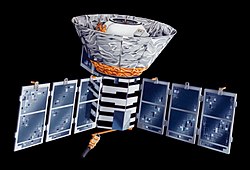Cosmic Background Explorer

Artist's concept of the COBE spacecraft
|
|||||||||
| Names | Explorer 66 | ||||||||
|---|---|---|---|---|---|---|---|---|---|
| Mission type | CMBR Astronomy | ||||||||
| Operator | NASA | ||||||||
| COSPAR ID | 1989-089A | ||||||||
| SATCAT no. | 20322 | ||||||||
| Website | lambda |
||||||||
| Mission duration | 4 years, 1 month, 5 days | ||||||||
| Spacecraft properties | |||||||||
| Manufacturer | GSFC | ||||||||
| Launch mass | 2,270 kg (5,000 lb) | ||||||||
| Dry mass | 1,408 kg (3,104 lb) | ||||||||
| Dimensions | 5.49 m × 2.44 m (18.0 ft × 8.0 ft) | ||||||||
| Power | 542 W | ||||||||
| Start of mission | |||||||||
| Launch date | 14:34, November 18, 1989 | ||||||||
| Rocket | Delta 5920-8 | ||||||||
| Launch site | SLC-2W Vandenberg | ||||||||
| End of mission | |||||||||
| Disposal | decommissioned | ||||||||
| Deactivated | December 23, 1993 | ||||||||
| Orbital parameters | |||||||||
| Reference system | Geocentric | ||||||||
| Regime | Sun-synchronous | ||||||||
| Semi-major axis | 7,255 km (4,508 mi) | ||||||||
| Eccentricity | 0.0009394 | ||||||||
| Perigee | 877.8 km (545.4 mi) | ||||||||
| Apogee | 891.4 km (553.9 mi) | ||||||||
| Inclination | 98.9808 degrees | ||||||||
| Period | 102.5 minutes | ||||||||
| RAAN | 215.4933 degrees | ||||||||
| Argument of perigee | 52.8270 degrees | ||||||||
| Mean anomaly | 351.1007 degrees | ||||||||
| Mean motion | 14.04728277 rev/day | ||||||||
| Epoch | 21 July 2015, 15:14:58 UTC | ||||||||
| Revolution no. | 31549 | ||||||||
| Main telescope | |||||||||
| Type | off-axis Gregorian (DIRBE) | ||||||||
| Diameter | 19 cm (7.5 in) | ||||||||
| Wavelengths | Microwave, Infrared | ||||||||
| Instruments | |||||||||
|
|||||||||
|
|
|||||||||
| Instruments | |
|---|---|
| DIRBE | Diffuse Infrared Background Experiment |
| FIRAS | Far-InfraRed Absolute Spectrophotometer |
| DMR | Differential Microwave Radiometer |
The Cosmic Background Explorer (COBE /ˈkoʊbi/), also referred to as Explorer 66, was a satellite dedicated to cosmology. Its goals were to investigate the cosmic microwave background radiation (CMB) of the universe and provide measurements that would help shape our understanding of the cosmos.
This work provided evidence that supported the Big Bang theory of the universe: that the CMB was a near-perfect black-body spectrum and that it had very faint anisotropies. Two of COBE's principal investigators, George Smoot and John Mather, received the Nobel Prize in Physics in 2006 for their work on the project. According to the Nobel Prize committee, "the COBE-project can also be regarded as the starting point for cosmology as a precision science".
In 1974, NASA issued an Announcement of Opportunity for astronomical missions that would use a small- or medium-sized Explorer spacecraft. Out of the 121 proposals received, three dealt with studying the cosmological background radiation. Though these proposals lost out to the Infrared Astronomical Satellite (IRAS), their strength made NASA further explore the idea. In 1976, NASA formed a committee of members from each of 1974's three proposal teams to put together their ideas for such a satellite. A year later, this committee suggested a polar-orbiting satellite called COBE to be launched by either a Delta rocket or the Space Shuttle. It would contain the following instruments:
...
Wikipedia

